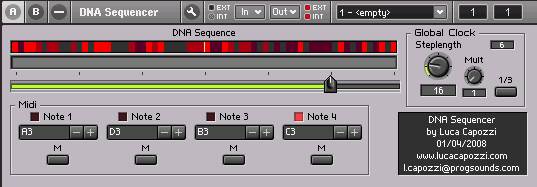
Using genetics to make music is very fun. During my researches I found that genetics algorithms are often used to create evolving patterns but, unfortunately, they do not sounds very musical. My approach is to program some Reaktor ensembles using simple yet musically effective genetic tricks to achive evolving rhythms and music patterns.
The first useful result is Helix, a drum machine featuring genetic crossing over technique.
The first useful result is Helix, a drum machine featuring genetic crossing over technique.

Pic. 1 - Helix
Four parents, coupled together, will generate eight children by using a simple pattern exchange. The split points are chosen using four random sequencers, one per parent. In this way the drum pattern evolves without losing his musical feel. The following example is a solo excerpt from a drum track used for the song Ka'tun IV.
Helix 1: Evolving drum pattern
As proof of concept here is a real application of Helix in my song Ka'tun IV, from the album Apocalypse Meow. Helix has been used to create evolving patterns against a "standard" drum loop.
Helix 2: Ka'tun IV (Apocalypse Meow - 2008)
The next result is a "simple" DNA sequencer.

For this one I've used a part of a virus genome got from one of various database available on the web. Just replace all letters with a numeric value and you can feed a Reaktor table and send out midi note numbers. This is pretty simple to do and can be the basics to more advanced techniques in order to develop "sound proteins" or simply mangle the outgoing notes in your favorite DAW.
As proof of concept an excerpt from my song Ostreococcus OSv5, from Apocalypse Meow, made using the DNA sequencer. The main drum loop comes from Reaktor's L3 ensemble while all other instruments are played using the DNA sequencer. The bass is played using the sequence as is while other percussions, guitars and pads by realtime processing incoming notes in Ableton Live.
As proof of concept an excerpt from my song Ostreococcus OSv5, from Apocalypse Meow, made using the DNA sequencer. The main drum loop comes from Reaktor's L3 ensemble while all other instruments are played using the DNA sequencer. The bass is played using the sequence as is while other percussions, guitars and pads by realtime processing incoming notes in Ableton Live.
DNA Sequence in Ostreococcus OSv5
All pictures and songs by Luca Capozzi
www.lucacapozzi.com
www.lucacapozzi.com
